|
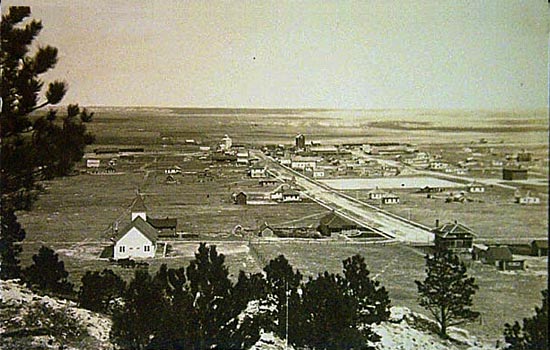
Pine Bluffs, Wyoming,
1914.
Luke Vorhees, former manager of the Deadwood Stage summarized the change that overcame Pine Bluffs from its founding:
In October, 1859, I rode from Pawnee Buttes north a few
miles to a heavy wooded butte, now called Pine Bluffs, (now
denuded of the "pine"), which overlooked a beautiful plain
or valley. It being the time of year when the buffalo were
migrating to the south, the entire valley as far as I could see
was one continuous herd of buffalo. A most beautiful sight,
although I had for two years been almost constantly in sight
of large herds of fine buffalo. This picture seemed to be the
most perfect of all of the great plain's panoramas.
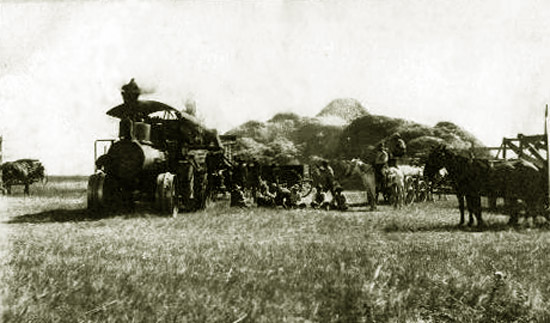
Threshing near Pine Bluffs,
I last fall, 1912, passed over the same valley and the
contrast was a most interesting one. Instead of the vast herds of
buffalo, the valley was much of it covered, or dotted with fields
and stacks of the finest of different kinds of grain. It seemed
to be a wonderful transformation, although fifty-three years
had elapsed, but it seemed only a few months from the time I
first viewed the buffalo, until the neat wheat fields appeared.
In 1908, the Pine Bluffs Post reported that there were six steam Plows in the area. Pine Bluffs became a
major shipping point on the Union Pacific for grain.
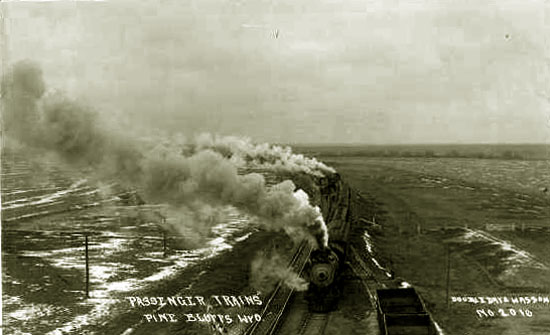
Trains at Pine Bluffs.
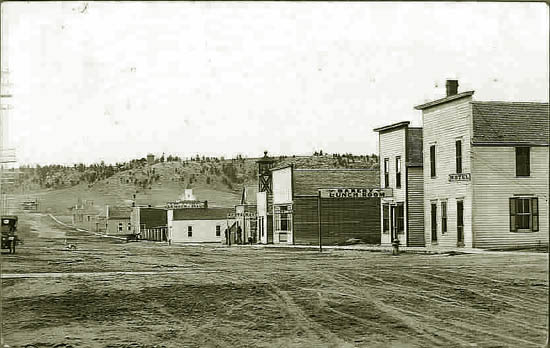
Pine Bluffs, looking south, 1914.
One of the two hotels is on the right, beyond is the bakery and lunchroom, further down the street is the town hall and
church.
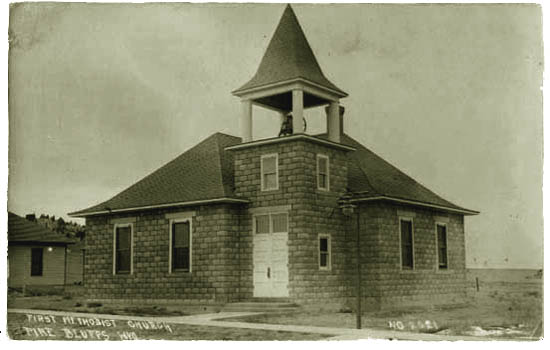
Methodist Church, Pine Bluffs,
1911.
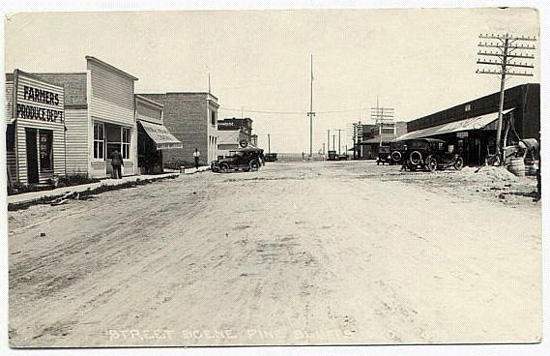
Pine Bluffs, 1920.
Today, in Pine Bluffs, one may during the the summer the University of Wyoming
Archaeological Museum and Site, and Our Lady of Peace, a five-story high statue of the
Virgin Mary sculpted by Robert Fida. Additionally, in the area are some 300 tipi circles left by
American Indians.
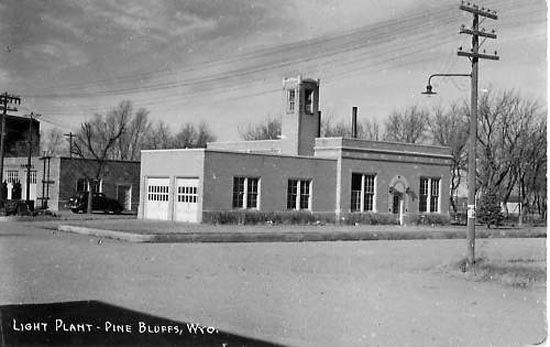
Pine Bluffs, Electric Company, c. 1940.
The electic company buidling has now been converted to a museum
devoted to the Texas Trail.
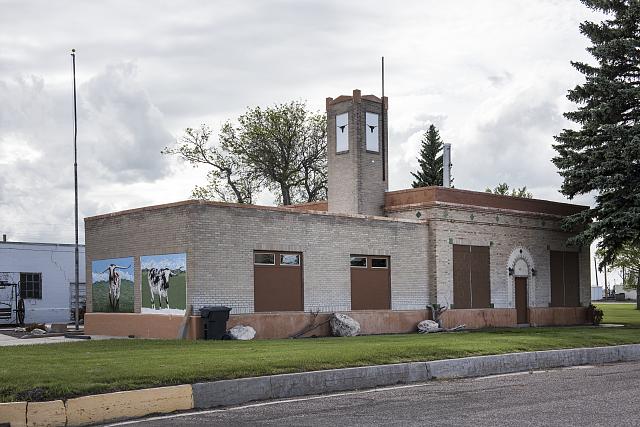
Texas Trail Museum, 2015. Photo by Carol Highsmith, courtesy of
Library of Congress/
For discussion of the Texas Trail see
Cattle Drives.
Many of the cattle companies who trailed cattle up from Texas are remembered in the Texas Trail
Monument in Pine Bluffs. The monument, erected in 1948, was sponsored by the Pine Buffs Lions Club, the Wyoming Stock Growers
Association and the families of Dudley Hiram Snyder (1933-1921 and John Wesley Snyder (1837-1922)
who first trailed cattle to
Wyoming in 1866 and later years..
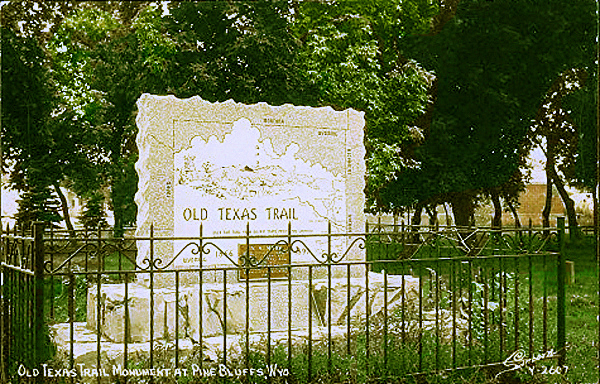
Texas Trail Monument, Pine Bluffs, approx. 1948.
Depicted on the back of the monument are the some of the brands that were trailed northward from
Texas.
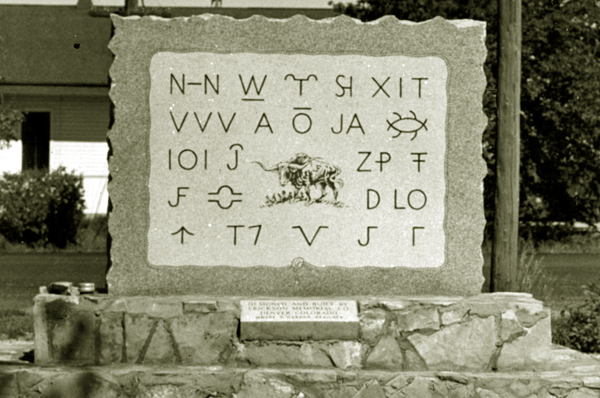
Texas Trail Monument, Pine Bluffs
First Row: "N Bar N," Wm. F. Niedringhaus and Frederick W. Niedringhaus, Panhandle City, Tex.;
W Bar, Pierre Wibaux, Wibaux Montana; "Ram's Horn," also sometimes referred to as the "Double Reverse J," Col. William D. Pickett,
Four Bear, Wyoming;
"S H Connected," Northern Cattle Company, Little Powder
River, Mont.; "X I T," Capitol Freehold and Investment Company.
Second Row: "Three V's," Western Ranches, Ltd, on the Belle Fource;
the "A;" Owner not identified; "Bar O," Standard Cattle Co. [Also used by J. W. Sacra, E. C. Suggs and J. W. Suggs, Salt Fork of the
Red River; the "J A," Charles Goodnight, Palo Duro Canyon, Texas; the "Bug," Carter Cattle Co., Ft. Bridger.
Third Row: "101," Standard Cattle Company, Moorcroft and Fallen County, Mt.; "Quarter Circle J," a registered brand in numerous states with various
owners.;
"Z P", Owner not identified; "T Bar", Teschmacher & DeBillier Cattle Company, Cheyenne, also used by
D. H. and J. W. Snyder, Cheyenne on cattle from Stonewall County, Texas.
Fourth Row: "J F". the Snyder Brothers, Williamson County, Texas, brand also depicted on the
longhorn in the center of the
monument; the "Double Mill Iron," Rocky Mountain Cattle Co, L. G. Phelps, Meeteetse, Wyoming; "D," J. L. Driskill & Son, Dallas, also used by J. J. Mann, Denver;
"L O," Mispah Live Stock Company, Miles City, Montana, also used by Swan Land and Cattle Co, Ltd.
Fifth Row: "Turkey Track" (sometimes referred to as the "Rafter I"), Hansford Land and Cattle Company;
"T 7," Thomas Matthews, Thunder Basin, Campbell County, Wyo.; "Flying V", Sheidley Cattle Co.,
Dakota Territory; "Flying J", J. B. Hunter, Buffalo, Ill.; "Blocker 7,"
trail brand of John R. Blocker of Texas;
For discussion of the various brands and cattle companies see
Brands and Branding.
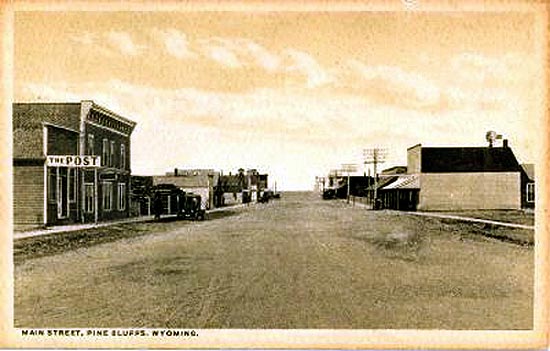
Pine Bluffs, 1910's
The Post was esablished by R. D. Wilson in 1908 and had its first office in the back room of the Abernathy Building. T
he area of Laramie County between Pine Bluffs and
F. E. Warren Air Base is a
center of archaelogical interest due to the presence of American Indians for at least 8,000 years and possibly as long as
11,000 years. When first settled by Indians the area was warmer in the winter and cooler and
wetter in the summer.
Music this page: "Lincoln Highway", courtesy Horse Creek Cowboy.
Next Page, Burns.
|